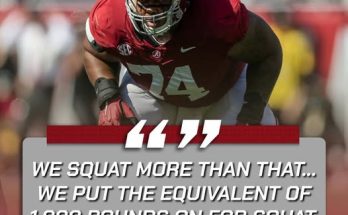In a world where the college football transfer portal has become a fixture of player movement and changing allegiances, stories of regret have begun to surface. One of the most notable instances of a player expressing remorse about their decision to leave a program is that of a former Ohio State Buckeyes player, whose time at the prestigious university ultimately became a source of reflection. While the transfer portal has provided athletes with the ability to chase new opportunities, it hasn’t always led to the success many expected. This player’s decision to leave Ohio State, a program renowned for its dominance and rich history, highlights the complexities of the modern college football landscape.
Ohio State University is synonymous with success, with a football program that is a perennial powerhouse in the Big Ten Conference and a constant fixture in the College Football Playoff discussion. The Buckeyes boast an unparalleled level of talent, consistently producing NFL-level players and maintaining a standard of excellence that attracts recruits from across the nation. For any player to leave such a prestigious program is a major decision, one that requires careful consideration of not only the potential for playing time but also the larger aspects of their future.
The player in question had arrived at Ohio State as a highly touted recruit, one of the many who had been drawn to the program’s rich tradition of success. Like many others, they had big dreams of contributing to the Buckeyes’ pursuit of national championships and making a name for themselves in the college football world. At first, everything seemed to be falling into place. The facilities were state-of-the-art, the coaching staff was among the best in the nation, and the competition within the team pushed them to new heights. However, as time wore on, the player began to feel increasingly frustrated with their lack of playing time. Despite their evident talent and potential, the player found themselves on the outside looking in, unable to crack the starting lineup.
It’s important to understand that Ohio State’s roster is stacked with talent at nearly every position, and for any player to secure a starting role requires an extraordinary level of performance in practice and during games. As the season progressed, the player began to realize that their opportunities were limited, with a deep pool of talent ahead of them in the depth chart. This realization, combined with the pressure of wanting to contribute to a program as prestigious as Ohio State, led to feelings of dissatisfaction. They began to question whether their future at the program would truly allow them to develop into the player they aspired to be.
The decision to transfer wasn’t made in haste. Like many athletes who contemplate leaving a program, the player weighed their options carefully. They evaluated other programs, considering which ones would provide more playing time, a better fit for their skills, and potentially a faster path to NFL prospects. The transfer portal provided a viable route to continue their college football career, and the opportunity to play at another school seemed too good to pass up. After all, the goal was always to play football at the highest level possible and to make a name for themselves in the sport. In the eyes of many players, transferring offers a chance for a fresh start.
When the player ultimately made the decision to leave Ohio State, it was met with both disappointment and understanding from the fan base. Ohio State fans are passionate and invested in the program’s success, and while they respected the player’s decision to seek more playing time, they couldn’t help but feel the loss of a highly talented individual from their roster. Fans and coaches alike were left to wonder what might have been had the player remained, but ultimately, they wished the best for the player’s future endeavors.
After transferring to their new school, the player initially felt a sense of relief and excitement. They were going to have the opportunity to prove themselves as a starter, to showcase their abilities in front of a new set of coaches and fans. However, the transition was far from smooth. In their new environment, they quickly realized that the level of competition was still fierce, albeit in a different way. While they were now a featured part of the team, the expectations remained high. The player struggled with the adjustment to a new system, new teammates, and a different style of coaching. Their confidence, which had been high during their time at Ohio State, began to waver as they found themselves facing challenges they hadn’t anticipated.
The playing time that had seemed so elusive at Ohio State was now within their grasp, but the player soon found themselves struggling to meet the high expectations placed upon them. The pressure to perform at a high level day in and day out began to take a toll on the player’s mental and physical health. They found themselves questioning their decision to leave Ohio State. The sense of familiarity, the comfort of being part of a well-established system, and the competitive nature of the Buckeyes’ roster were all things they missed. In hindsight, they realized that the level of competition and the environment at Ohio State had been precisely what they needed to grow as a player. Despite the lack of playing time, the opportunity to practice against some of the best athletes in the nation had prepared them in ways they hadn’t fully appreciated at the time.
As the player navigated their new school, they began to reflect on the lessons they had learned during their time at Ohio State. They realized that the decision to transfer had been driven by a desire for immediate gratification—the hope of playing more, of being a star on a team that needed them. However, they now understood that success in college football doesn’t always come in the form of immediate playing time or recognition. Sometimes, growth happens behind the scenes, through hard work and perseverance. The player’s time at Ohio State had been filled with valuable learning experiences, even if it hadn’t always been in the form of game action.
One of the most significant aspects of the player’s regret was the realization that leaving Ohio State meant leaving behind a strong network of mentors, coaches, and teammates who could have helped them reach their full potential. At Ohio State, the coaching staff, led by some of the brightest minds in college football, had a wealth of experience and knowledge. They had access to top-tier resources and facilities that could have aided in their development. In retrospect, the player came to understand that their desire for immediate success had blinded them to the long-term benefits of staying in a program as prestigious as Ohio State.
The experience also gave the player a greater appreciation for the importance of patience in a player’s development. College football is a grind, and every athlete’s journey is different. Some players may start immediately, while others may need time to grow into their role. The player’s initial frustration with their lack of playing time at Ohio State had clouded their judgment and led them to make a decision that they would later regret. Had they stayed at Ohio State, they might have eventually earned their place on the field, and their growth as a player would have been more gradual but ultimately more fulfilling.
Ultimately, the player’s story serves as a reminder of the complexities of the modern college football landscape. The transfer portal has undoubtedly created new opportunities for players, but it has also introduced new challenges. It’s easy for athletes to get caught up in the desire for immediate playing time and recognition, but the process of becoming a top-tier player is often a slow and difficult one. The regret that the former Ohio State player feels today serves as a testament to the value of patience, hard work, and the willingness to trust the process.
As they continue their career at their new school, the player has vowed to use their experience as a lesson for others. They encourage future recruits and transfer portal entrants to carefully consider the long-term consequences of their decisions. While the grass may always seem greener on the other side, sometimes staying in a program with a strong tradition, elite coaching, and intense competition can be the key to unlocking one’s full potential. The player now knows that the journey to success in college football is never linear, and sometimes the best decision is the one that doesn’t promise immediate rewards, but instead offers the chance for growth and development in the long run.



